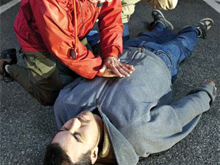Health Topics
-
Healthy Living
-
|
|
February 2012
|
| Emergency Care for Heart Attacks and Strokes |
| Dr Priyadarshini Pal Singh |
| |
 |
The majority of people, who die from a heart attack, do so within one hour of experiencing the first symptoms of an attack. Strokes are similar medical emergencies that can result in permanent damage to the brain and may also result in death. That’s why when stroke or chest pain strikes, it is important to seek medical help immediately. |
Heart Attack Warning
- Discomfort in the chest - Most cases of heart attacks have patients suffering from uneasiness in the centre of the chest. The discomfort is intermittent and feels like an uncomfortable pressure, pain or squeezing sensation that comes and goes.
- Discomfort in other areas of the body– The upper body may experience pain and uneasiness, especially in the arms, back, jaw, neck or stomach (making it mimic the symptoms of dyspepsia).
- Shortness of breath – The person starts feeling breathless which may or may not be accompanied by chest discomfort.
- Feeling faint – Feeling lightheaded and woozy is very common.
- Cold sweat – The person breaks out into a cold sweat as he or she experiences shortness of breath.
- Nausea or vomiting.
Aid for Heart Attack
- Call for emergency help immediately, stating the casualty as a heart attack.
- If the heart stops beating, place the palm of your hand on the patient’s chest. Position it over the centre of chest on the breastbone (imaginary line between two nipples) and put your other hand over it. Press your hand in a pumping motion once or twice. This may make the heart beat again.
- If anyone around knows how to administer CPR, it should be administered along with pumping the heart.
- Wait for medical aid to arrive, even if the patient is resuscitated, and get the person to a doctor.
Warning signs of Stroke
- Dizziness – The person has sudden trouble while walking, starts getting dizzy and has problems with balance and coordination.
- Facial deviation to one side.
- Weakness or numbness of arm or leg on either or both sides of body.
- Slurring of speech – Trouble in talking, confusion in framing words and difficulty in understanding speech.
- Loss of vision – Unexplainable and sudden change in vision or loss of sight, signals a stroke
- Headache – Severe headache without any reason is experienced sometimes
|
Aid for Stroke
- If you suspect that a person is having a stroke, call for medical help immediately.
- If the patient is not breathing and has no pulse, start CPR.
- Hypoglycaemia in diabetic patient can mimic stroke. Check RBS by glucometer if available and give sugar if patient can take orally.
- Immediately transfer the patient to a hospital where CT scan facility is available.
Treatment within the ‘Golden Hour’ is more successful because patients are candidates for the powerful clot-busting drug known as TPA (tissue plasminogen activator), which must be given within the first four hours after the onset of symptoms. The reason its ‘GOLDEN’ is that stroke patients have a much greater chance of surviving and avoiding long term brain damage, if they arrive at the hospital and receive treatment within the first hour. |
Dr Priyadarshini Pal Singh is the Head, Dept. of Accident and Emergency, Apollo Indraprastha Hospital, New Delhi
|
|
|
|